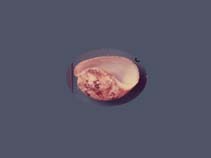Bulla ampulla (Linnaeus, 1758)
Pacific blue snailWarning: DOMDocument::load(): SSL operation failed with code 1. OpenSSL Error messages: error:140770FC:SSL routines:SSL23_GET_SERVER_HELLO:unknown protocol in C:\Apache24\htdocs\includes\SpeciesSummary.lib.php on line 1236
Warning: DOMDocument::load(): Failed to enable crypto in C:\Apache24\htdocs\includes\SpeciesSummary.lib.php on line 1236
Warning: DOMDocument::load(https://sealifebase.nrm.se/webservice/AquaMaps/getAMap.php?genus=Bulla&species=ampulla): failed to open stream: operation failed in C:\Apache24\htdocs\includes\SpeciesSummary.lib.php on line 1236
Warning: DOMDocument::load(): I/O warning : failed to load external entity "https://sealifebase.nrm.se/webservice/AquaMaps/getAMap.php?genus=Bulla&species=ampulla" in C:\Apache24\htdocs\includes\SpeciesSummary.lib.php on line 1236
Classification / Names Common names | Synonyms | CoL | ITIS | WoRMS
| Cephalaspidea | Bullidae
Environment: milieu / climate zone / depth range / distribution range Ecología
; rango de profundidad 0 - 165 m (Ref. 107300). Tropical
Distribución Países | Áreas FAO | Ecosistemas | Ocurrencias, apariciones | Introducciones
Indo-Pacific, Southeast Atlantic and the Mediterranean.
Length at first maturity / Tamaño / Peso / Age
Maturity: Lm ? range ? - ? cm Max length : 5.0 cm TL macho / no sexado; (Ref. 844)
Assumed maximum length from Ref. 844. A strictly herbivorous species that is common on rocky reefs (Ref. 844), and always found around soft silt or mud in where it is usually buried (Ref. 866) during the day (Ref. 107294); common in deep rock pools and tidal swimming pools (Ref. 866). Nocturnal. Emerges at night to feed on seaweeds and grasses (Ref. 107294).
Life cycle and mating behavior Madurez | Reproducción | Puesta | Huevos | Fecundidad | Larva
Members of the order Cephalaspidea are mostly simultaneous hermaphrodites.
Main reference
Referencias | Coordinador | Colaboradores
Debelius, H. 2001. (Ref. 844)
IUCN Red List Status (Ref. 130435)
CITES status (Ref. 108899)
Not Evaluated
CMS (Ref. 116361)
Not Evaluated
Threat to humans
Human uses
| FishSource |
Herramientas
Más información
Fuentes de Internet
BHL | BOLD Systems | CISTI | DiscoverLife | FAO(Publication : search) | Fishipedia | GenBank (genome, nucleotide) | GloBI | Gomexsi | Google Books | Google Scholar | Google | PubMed | Árbol de la vida | Wikipedia (Go, búsqueda) | Expediente Zoológico
Estimates based on models
Preferred temperature
(Ref. 115969): 23.7 - 29, mean 27.5 (based on 986 cells).
Price category
(Ref. 80766):
Unknown.



